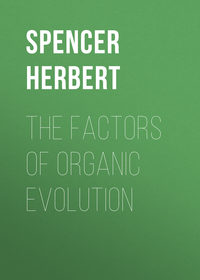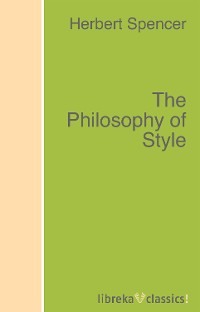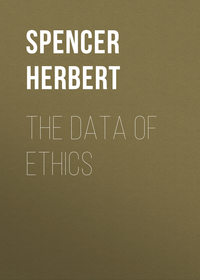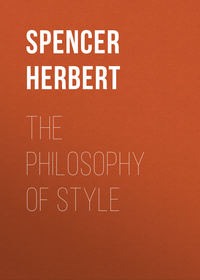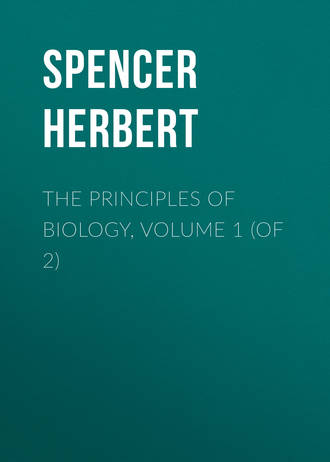 полная версия
полная версияThe Principles of Biology, Volume 1 (of 2)
In a developing embryo, the functions or more strictly the structures which are to perform them, arise in the same general order. A like primary distinction very early appears between the endoderm and the ectoderm – the part which has the office of accumulating energy, and the part out of which grow those organs that are the great expenders of energy. Between these two there presently arises the mesoderm in which becomes visible the rudiment of that vascular system, which has to fulfil the intermediate duty of transferring energy. Of these three general functions, that of accumulating energy is carried on from the outset: the endoderm, even while yet incompletely differentiated from the ectoderm, absorbs nutritive matters from the subjacent yelk. The transfer of energy is also to some extent effected by the rudimentary vascular system, as soon as its central cavity and attached vessels are sketched out. But the expenditure of energy (in the higher animals at least) is not appreciably displayed by those ectodermic and mesodermic structures that are afterwards to be mainly devoted to it: there is no sphere for the actions of these parts. Similarly with the chief subdivisions of these fundamental functions. The distinction first established separates the office of transforming other energy into mechanical motion, from the office of liberating the energy to be so transformed. While in the layer between endoderm and ectoderm are arising the rudiments of the muscular system, there is marked out in the ectoderm the rudiment of the nervous system. This indication of structures which are to share between them the general duty of expending energy, is soon followed by changes that foreshadow further specializations of this general duty. In the incipient nervous system there begins to arise that contrast between the cerebral mass and the spinal cord, which, in the main, answers to the division of nervous actions into directive and executive; and, at the same time, the appearance of vertebral laminæ foreshadows the separation of the osseous system, which has to resist the strains of muscular action, from the muscular system, which, in generating motion, entails these strains. Simultaneously there have been going on similar actual and potential specializations in the functions of accumulating energy and transferring energy. And throughout all subsequent phases the method is substantially the same.
This progress from general, indefinite, and simple kinds of action to special, definite, and complex kinds of action, has been aptly termed by Milne-Edwards, "the physiological division of labour." Perhaps no metaphor can more truly express the nature of this advance from vital activity in its lowest forms to vital activity in its highest forms. And probably the general reader cannot in any other way obtain so clear a conception of functional development in organisms, as he can by tracing out functional development in societies: noting how there first comes a distinction between the governing class and the governed class; how while in the governing class there slowly grow up such differences of duty as the civil, military, and ecclesiastical, there arise in the governed class fundamental industrial differences like those between agriculturists and artizans; and how there is a continual multiplication of such specialized occupations and specialized shares of each occupation.
§ 59. Fully to understand this change from homogeneity of function to heterogeneity of function, which accompanies the change from homogeneity of structure to heterogeneity of structure, it is needful to contemplate it under a converse aspect. Standing alone, the above exposition conveys an idea that is both inadequate and erroneous. The divisions and subdivisions of function, becoming definite as they become multiplied, do not lead to a more and more complete independence of functions; as they would do were the process nothing beyond that just described; but by a simultaneous process they are rendered more mutually dependent. While in one respect they are separating from each other, they are in another respect combining with each other. At the same time that they are being differentiated they are also being integrated. Some illustrations will make this plain.
In animals which display little beyond the primary differentiation of functions, the activity of that part which absorbs nutriment or accumulates energy, is not immediately bound up with the activity of that part which, in producing motion, expends energy. In the higher animals, however, the performance of the alimentary functions depends on the performance of various muscular and nervous functions. Mastication and swallowing are nervo-muscular acts; the rhythmical contractions of the stomach and the allied vermicular motions of the intestines, result from the reflex stimulation of certain muscular coats caused by food; the secretion of the several digestive fluids by their respective glands, is due to nervous excitation of them; and digestion, besides requiring these special aids, is not properly performed in the absence of a continuous discharge of energy from the great nervous centres. Again, the function of transferring nutriment or latent energy, from part to part, though at first not closely connected with the other functions, eventually becomes so. The short contractile tube which propels backwards and forwards the blood contained in the peri-visceral cavity of an ascidian, is neither structurally nor functionally much entangled with the creature's other organs. But on passing upwards through higher types, in which this simple tube is replaced by a system of branched tubes, that deliver their contents through their open ends into the tissues at distant parts; and on coming to those advanced types which have closed arterial and venous systems, ramifying minutely in every corner of every organ; we find that the vascular apparatus, while it has become structurally interwoven with the whole body, has become unable properly to fulfil its office without the help of offices that are quite separated from its own. The heart, though mainly automatic in its actions, is controlled by the nervous system, which takes a share in regulating the contractions both of the heart and the arteries. On the due discharge of the respiratory function, too, the function of circulation is directly dependent: if the aeration of the blood is impeded the vascular activity is lowered; and arrest of the one very soon causes stoppage of the other. Similarly with the duties of the nervo-muscular system. Animals of low organization, in which the differentiation and integration of the vital actions have not been carried far, will move about for a considerable time after being eviscerated, or deprived of those appliances by which energy is accumulated and transferred. But animals of high organization are instantly killed by the removal of these appliances, and even by the injury of minor parts of them: a dog's movements are suddenly brought to an end, by cutting one of the main canals along which the materials that evolve movements are conveyed. Thus while in well-developed creatures the distinction of functions is very marked, the combination of functions is very close. From instant to instant the aeration of blood implies that certain respiratory muscles are being made to contract by nervous impulses passing along certain nerves; and that the heart is duly propelling the blood to be aerated. From instant to instant digestion proceeds only on condition that there is a supply of aerated blood, and a due current of nervous energy through the digestive organs. That the heart of a mammal may act, its muscle substance must be continuously fed with an abundant supply of arterial blood.
It is not easy to find an adequate expression for this double re-distribution of functions. It is not easy to realize a transformation through which the functions thus become in one sense separated and in another sense combined, or even interfused. Here, however, as before, an analogy drawn from social organization helps us. If we observe how the increasing division of labour in societies is accompanied by a closer co-operation; and how the agencies of different social actions, while becoming in one respect more distinct, become in another respect more minutely ramified through one another; we shall understand better the increasing physiological co-operation that accompanies increasing physiological division of labour. Note, for example, that while local divisions and classes of the community have been growing unlike in their several occupations, the carrying on of their several occupations has been growing dependent on the due activity of that vast organization by which sustenance is collected and diffused. During the early stages of social development, every small group of people, and often every family, obtained separately its own necessaries; but now, for each necessary, and for each superfluity, there exists a combined body of wholesale and retail distributors, which brings its branched channels of supply within reach of all. While each citizen is pursuing a business that does not immediately aim at the satisfaction of his personal wants, his personal wants are satisfied by a general agency which brings from all places commodities for him and his fellow-citizens – an agency which could not cease its special duties for a few days, without bringing to an end his own special duties and those of most others. Consider, again, how each of these differentiated functions is everywhere pervaded by certain other differentiated functions. Merchants, manufacturers, wholesale distributors of their several species, together with lawyers, bankers, &c., all employ clerks. In clerks we have a specialized class dispersed through various other classes; and having its function fused with the different functions of these various other classes. Similarly commercial travellers, though having in one sense a separate occupation, have in another sense an occupation forming part of each of the many occupations which it aids. As it is here with the sociological division of labour, so is it with the physiological division of labour above described. Just as we see in an advanced community, that while the magisterial, the clerical, the medical, the legal, the manufacturing, and the commercial activities, have grown distinct, they have yet their agencies mingled together in every locality; so in a developed organism, we see that while the general functions of circulation, secretion, absorption, excretion, contraction, excitation, &c., have become differentiated, yet through the ramifications of the systems apportioned to them, they are closely combined with one another in every organ.
§ 60. The physiological division of labour is usually not carried so far as wholly to destroy the primary physiological community of labour. As in societies the adaptation of special classes to special duties, does not entirely disable these classes from performing one another's duties on an emergency; so in organisms, tissues and structures that have become fitted to the particular offices they have ordinarily to discharge, often remain partially able to discharge other offices. It has been pointed out by Dr. Carpenter, that "in cases where the different functions are highly specialized, the general structure retains, more or less, the primitive community of function which originally characterized it." A few instances will bring home this generalization.
The roots and leaves of plants are widely differentiated in their functions: by the roots, water and mineral substances are absorbed; while the leaves take in, and decompose, carbonic acid. Nevertheless, by many botanists it is held that some leaves, or parts of them, can absorb water; and in what are popularly called "air-plants," or at any rate in some kinds of them, the absorption of water is mainly and in some cases wholly carried on by them and by the stems. Conversely, the underground parts can partially assume the functions of leaves. The exposed tuber of a potato develops chlorophyll on its surface, and in other cases, as in that of the turnip, roots, properly so called, do the like. In trees the trunks, which have in great measure ceased to produce buds, recommence producing them if the branches are cut off; sometimes aerial branches send down roots to the earth; and under some circumstances the roots, though not in the habit of developing leaf-bearing organs, send up numerous suckers. When the excretion of bile is arrested, part goes to the skin and some to the kidneys, which presently suffer under their new task. Various examples of vicarious functions may be found among animals. The excretion of carbonic acid and absorption of oxygen are mainly performed by the lungs, in creatures which have lungs; but in such creatures there continues a certain amount of cutaneous respiration, and in soft-skinned batrachians like the frog, this cutaneous respiration is important. Again, when the kidneys are not discharging their duties a notable quantity of urea is got rid of by perspiration. Other instances are supplied by the higher functions. In man the limbs, which among lower vertebrates are almost wholly organs of locomotion, are specialized into organs of locomotion and organs of manipulation. Nevertheless, the human arms and legs do, when needful, fulfil, to some extent, each other's offices. Not only in childhood and old age are the arms used for purposes of support, but on occasions of emergency, as when mountaineering, they are used by men in full vigour. And that legs are to a considerable degree capable of performing the duties of arms, is proved by the great amount of manipulatory skill reached by them when the arms are absent. Among the perceptions, too, there are examples of partial substitution. The deaf Dr. Kitto described himself as having become excessively sensitive to vibrations propagated through the body; and as so having gained the power of perceiving, through his general sensations, those neighbouring concussions of which the ears ordinarily give notice. Blind people make hearing perform, in part, the office of vision. Instead of identifying the positions and sizes of neighbouring objects by the reflection of light from their surfaces, they do this in a rude way by the reflection of sound from their surfaces.
We see, as we might expect to see, that this power of performing more general functions, is great in proportion as the organs have been but little adapted to their special functions. Those parts of plants which show so considerable an ability to discharge each others' offices, are not widely unlike in their minute structures. And the tissues which in animals are to some extent mutually vicarious, are tissues in which the original cellular composition is still conspicuous. But we do not find evidence that the muscular, nervous, or osseous tissues are able in any degree to perform those processes which the less differentiated tissues perform. Nor have we any proof that nerve can partially fulfil the duty of muscle, or muscle that of nerve. We must say, therefore, that the ability to resume the primordial community of function, varies inversely as the established specialization of function; and that it disappears when the specialization of function becomes great.
§ 61. Something approaching to a priori reasons may be given for the conclusions thus reached a posteriori. They must be accepted for as much as they seem worth.
It may be argued that on the hypothesis of Evolution, Life necessarily comes before organization. On this hypothesis, organic matter in a state of homogeneous aggregation must precede organic matter in a state of heterogeneous aggregation. But since the passing from a structureless state to a structured state, is itself a vital process, it follows that vital activity must have existed while there was yet no structure: structure could not else arise. That function takes precedence of structure, seems also implied in the definition of Life. If Life is shown by inner actions so adjusted as to balance outer actions – if the implied energy is the substance of Life while the adjustment of the actions constitutes its form; then may we not say that the actions to be formed must come before that which forms them – that the continuous change which is the basis of function, must come before the structure which brings function into shape? Or again, since in all phases of Life up to the highest, every advance is the effecting of some better adjustment of inner to outer actions; and since the accompanying new complexity of structure is simply a means of making possible this better adjustment; it follows that the achievement of function is, throughout, that for which structure arises. Not only is this manifestly true where the modification of structure results by reaction from modification of function; but it is also true where a modification of structure otherwise produced, apparently initiates a modification of function. For it is only when such so-called spontaneous modification of structure subserves some advantageous action, that it is permanently established. If it is a structural modification that happens to facilitate the vital activities, "natural selection" retains and increases it; but if not, it disappears.
The connexion which we noted between heterogeneity of structure and heterogeneity of function – a connexion made so familiar by experience as to appear scarcely worth specifying – is clearly a necessary one. It follows from the general truth that in proportion to the heterogeneity of any aggregate, is the heterogeneity it will produce in any incident force (First Principles, § 156). The energy continually liberated in the organism by decomposition, is here the incident force; the functions are the variously modified forms produced in its divisions by the organs they pass through; and the more multiform the organs the more multiform must be the differentiations of the force passing through them.
It follows obviously from this, that if structure progresses from the homogeneous, indefinite, and incoherent, to the heterogeneous, definite, and coherent, so too must function. If the number of different parts in an aggregate must determine the number of differentiations produced in the energies passing through it – if the distinctness of these parts from one another, must involve distinctness in their reactions, and therefore distinctness between the divisions of the differentiated energy; there cannot but be a complete parallelism between the development of structure and the development of function. If structure advances from the simple and general to the complex and special, function must do the same.
CHAPTER IV.
WASTE AND REPAIR
§ 62. Throughout the vegetal kingdom, the processes of Waste and Repair are comparatively insignificant in their amounts. Though all parts of plants save the leaves, or other parts which are green, give out carbonic acid; yet this carbonic acid, assuming it to indicate consumption of tissue, or rather of the protoplasm contained in the tissue, indicates but a small consumption. Of course if there is little waste there can be but little repair – that is, little of the interstitial repair which restores the integrity of parts worn by functional activity. Nor, indeed, is there displayed by plants in any considerable degree, if at all, that other species of repair which consists in the restoration of lost or injured organs. Torn leaves and the shoots that are shortened by the pruner, do not reproduce their missing parts; and though when the branch of a tree is cut off close to the trunk, the place is in course of years covered over, it is not by any reparative action in the wounded surface but by the lateral growth of the adjacent bark. Hence, without saying that Waste and Repair do not go on at all in plants, we may fitly pass them over as of no importance.
There are but slight indications of waste in those lower orders of animals which, by their comparative inactivity, show themselves least removed from vegetal life. Actiniæ kept in an aquarium, do not appreciably diminish in bulk from prolonged abstinence. Even fish, though much more active than most other aquatic creatures, appear to undergo but little loss of substance when kept unfed during considerable periods. Reptiles, too, maintaining no great temperature, and passing their lives mostly in a state of torpor, suffer but little diminution of mass by waste. When, however, we turn to those higher orders of animals which are active and hot-blooded, we see that waste is rapid: producing, when unchecked, a notable decrease in bulk and weight, ending very shortly in death. Besides finding that waste is inconsiderable in creatures which produce but little insensible and sensible motion, and that it becomes conspicuous in creatures which produce much insensible and sensible motion; we find that in the same creatures there is most waste when most motion is generated. This is clearly proved by hybernating animals. "Valentin found that the waking marmot excreted in the average 75 times more carbonic acid, and inhaled 41 times more oxygen than the same animal in the most complete state of hybernation. The stages between waking and most profound hybernation yielded intermediate figures. A waking hedgehog yielded about 20.5 times more carbonic acid, and consumed 18.4 times more oxygen than one in the state of hybernation."22 If we take these quantities of absorbed oxygen and excreted carbonic acid, as indicating something like the relative amounts of consumed organic substance, we see that there is a striking contrast between the waste accompanying the ordinary state of activity, and the waste accompanying complete quiescence and reduced temperature. This difference is still more definitely shown by the fact, that the mean daily loss from starvation in rabbits and guinea-pigs, bears to that from hybernation, the proportion of 18.3:1. Among men and domestic animals, the relation between degree of waste and amount of expended energy, though one respecting which there is little doubt, is less distinctly demonstrable; since waste is not allowed to go on uninterfered with. We have, however, in the lingering lives of invalids who are able to take scarcely any nutriment but are kept warm and still, an illustration of the extent to which waste diminishes as the expenditure of energy declines.
Besides the connexion between the waste of the organism as a whole and the production of sensible and insensible motion by the organism as a whole, there is a traceable connexion between the waste of special parts and the activities of such special parts. Experiments have shown that "the starving pigeon daily consumes in the average 40 times more muscular substance that the marmot in the state of torpor, and only 11 times more fat, 33 times more of the tissue of the alimentary canal, 18.3 times more liver, 15 times more lung, 5 times more skin." That is to say, in the hybernating animal the parts least consumed are the almost totally quiescent motor-organs, and the part most consumed is the hydro-carbonaceous deposit serving as a store of energy; whereas in the pigeon, similarly unsupplied with food but awake and active, the greatest loss takes place in the motor-organs. The relation between special activity and special waste, is illustrated, too, in the daily experiences of all: not indeed in the amount of decrease of the active parts in bulk or weight, for this we have no means of ascertaining; but in the diminished ability of such parts to perform their functions. That legs exerted for many hours in walking and arms long strained in rowing, lose their powers – that eyes become enfeebled by reading or writing without intermission – that concentrated attention, unbroken by rest, so prostrates the brain as to incapacitate it for thinking; are familiar truths. And though we have no direct evidence to this effect, there is little danger in concluding that muscles exercised until they ache or become stiff, and nerves of sense rendered weary or obtuse by work, are organs so much wasted by action as to be partially incompetent.
Repair is everywhere and always making up for waste. Though the two processes vary in their relative rates both are constantly going on. Though during the active, waking state of an animal waste is in excess of repair, yet repair is in progress; and though during sleep repair is in excess of waste, yet some waste is necessitated by the carrying on of certain never-ceasing functions. The organs of these never-ceasing functions furnish, indeed, the most conclusive proofs of the simultaneity of repair and waste. Day and night the heart never stops beating, but only varies in the rapidity and vigour of its beats; and hence the loss of substance which its contractions from moment to moment entail, must from moment to moment be made good. Day and night the lungs dilate and collapse; and the muscles which make them do this must therefore be kept in a state of integrity by a repair which keeps pace with waste, or which alternately falls behind and gets in advance of it to a very slight extent.






